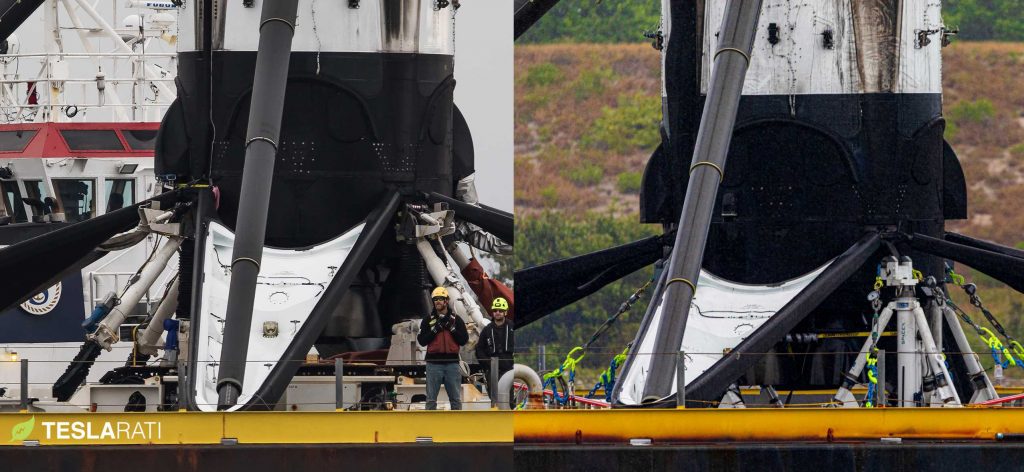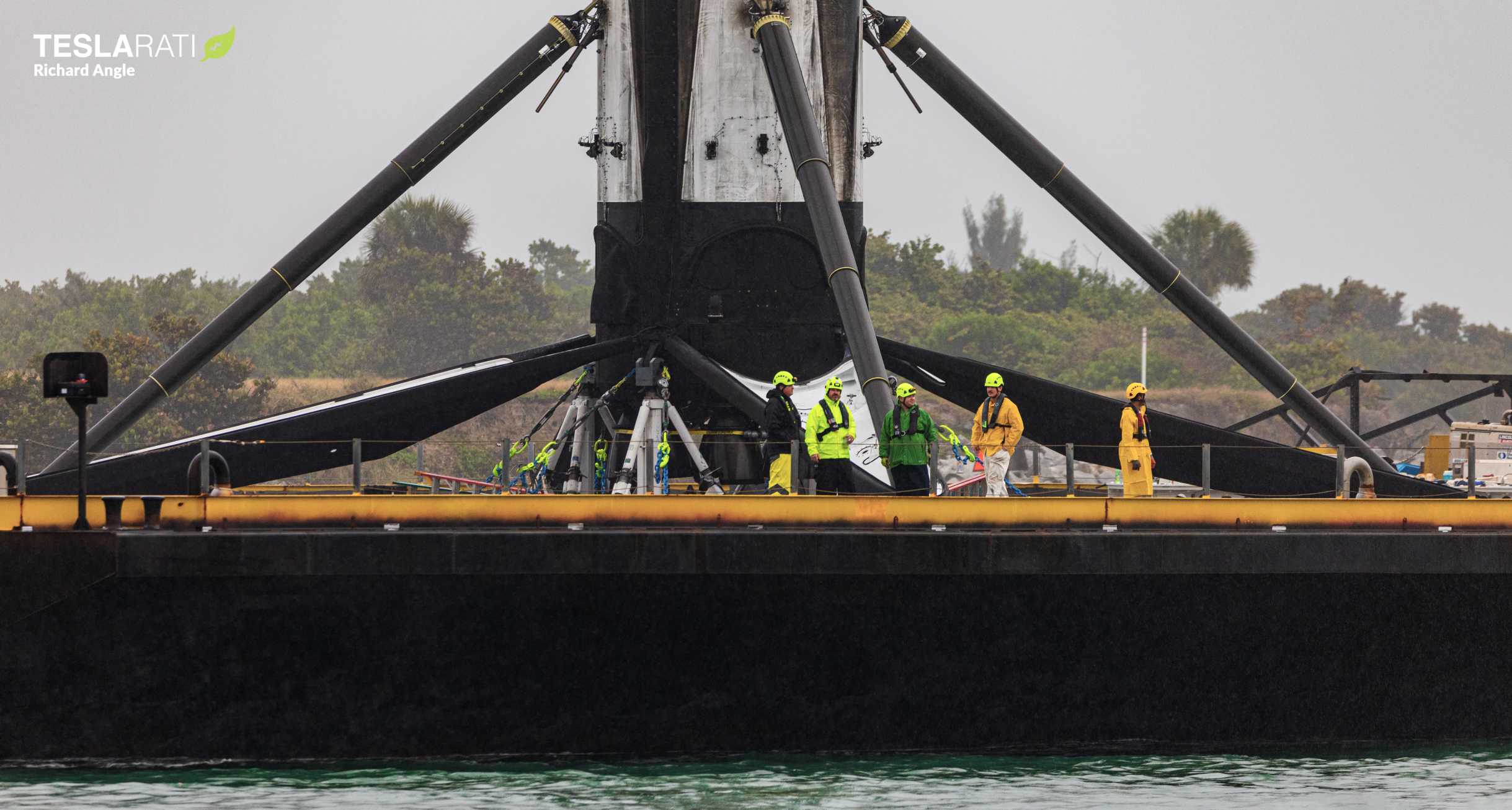
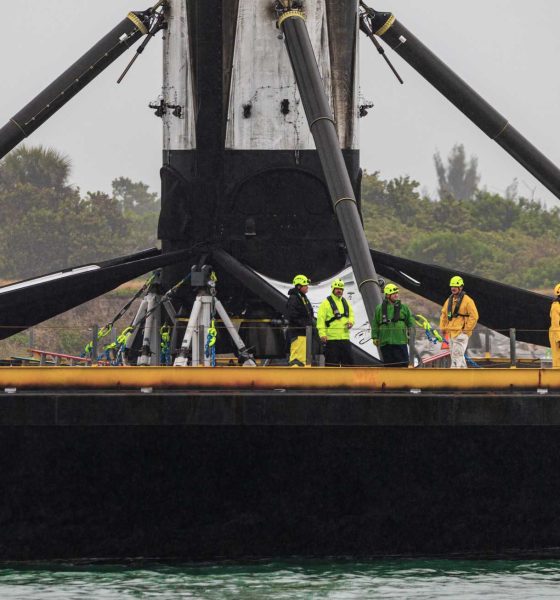
News
SpaceX rocket booster makes it back to port after hard drone ship landing
SpaceX has completed its third rocket launch of 2020 and the most recent booster to launch safely returned to Port Canaveral on Saturday after an exceptionally hard drone ship landing.
Falcon 9 booster (first stage) B1051 lifted off for the third time on January 29th, following up two prior orbital-class missions by placing SpaceX’s fourth batch of 60 Starlink satellites into low Earth orbit (LEO). B1051 debuted on March 2nd, 2019 when it became the first Falcon 9 rocket to launch SpaceX’s next-generation Crew Dragon spacecraft, successfully sending the vehicle on its way to what would end up being a flawless rendezvous with the International Space Station (ISS). Less than four months later, B1051 completed its second mission, this time lifting off from SpaceX’s Vandenberg Air Force Base (VAFB), California facilities before landing in zero-visibility fog conditions just a thousand feet from the pad.
Compared to some of the higher-energy geostationary (high orbit) launches SpaceX often performs, B1051’s two prior launches allowed for relatively gentle reentries and landings. On January 29th, 2020, after sending SpaceX’s 3rd batch of upgraded Starlink v1.0 satellites (Starlink V1 L3) on their way to space, the Falcon 9 booster experienced the hardest successful landing seen after a SpaceX launch in quite some time.
With Starlink V1 L3 complete, SpaceX has officially launched an incredible 120 satellites weighing some 32 metric tons (70,500 lb) in a single month – 22 days, to be precise. If everything goes as planned, those two monthly Starlink launches should become SpaceX’s average over the rest of 2020, necessary to satisfy the company’s goal of completing 20-24 Starlink launches this year alone. If SpaceX replicates its January successes this month, the company’s Starlink constellation – already ~230 satellites strong – may even be ready to start serving internet to customers in the northern US and Canada as early as March 2020, less than two months from now.
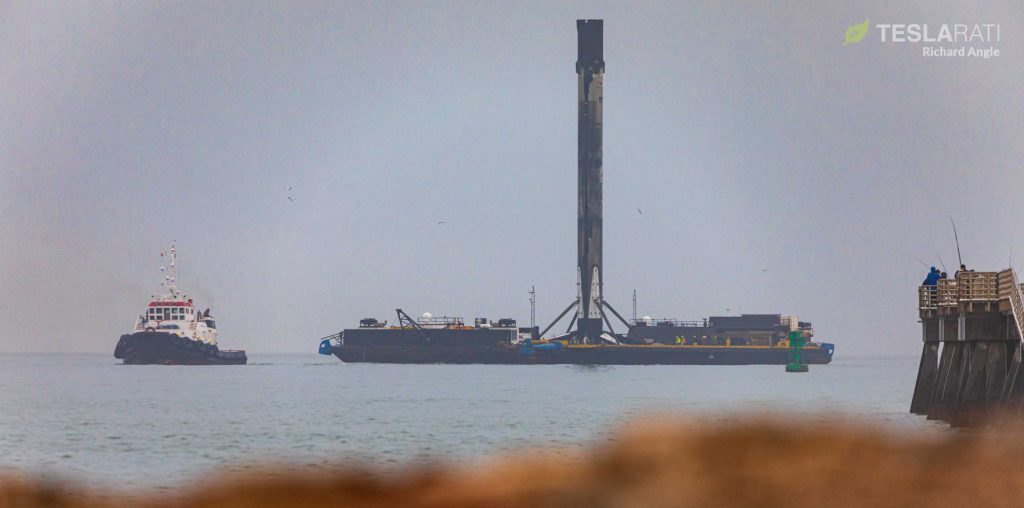
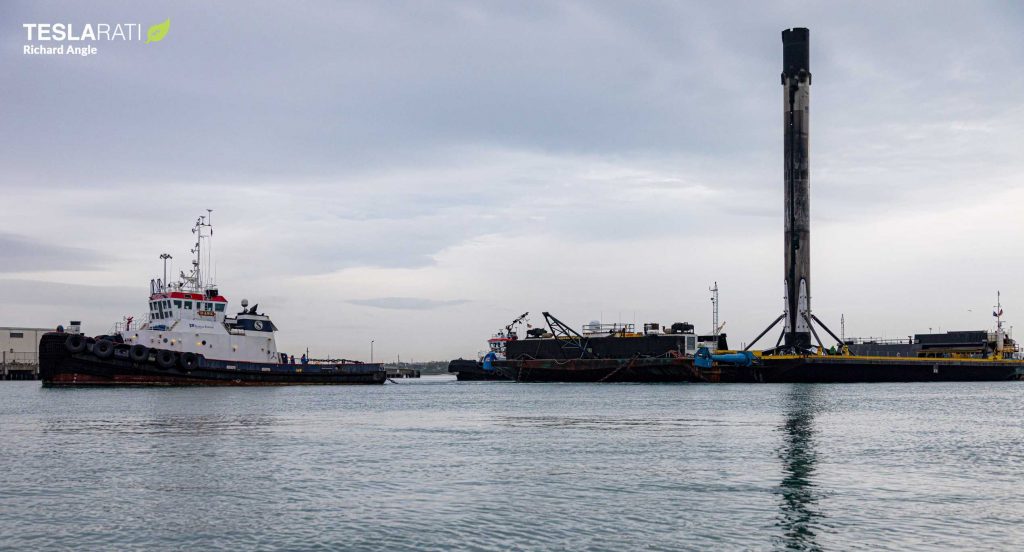
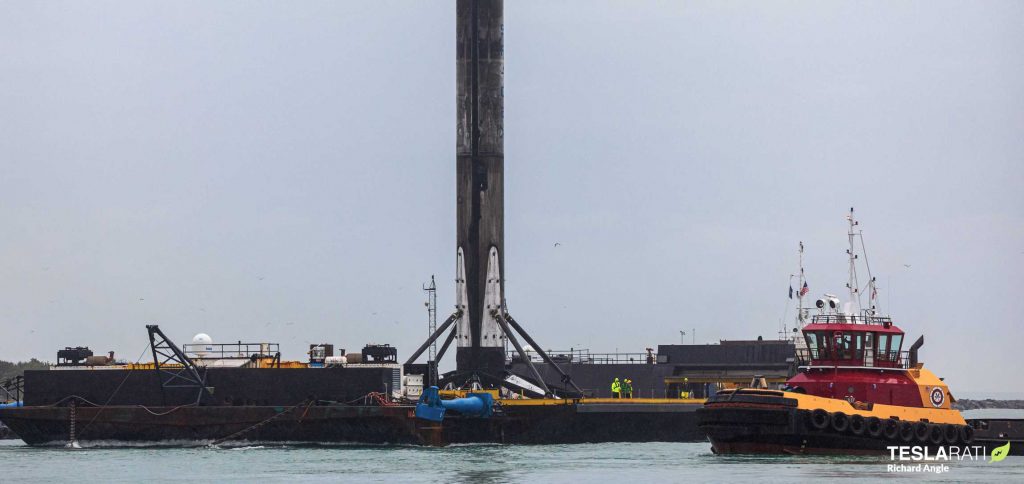
Meanwhile, the mission marked SpaceX’s second Falcon 9 landing and recovery of the new year, as well as the sixth time an orbital-class SpaceX booster has completed three launches. SpaceX continues to push the envelope of reusable rocketry ever since it debuted Falcon 9’s Block 5 upgrade in May 2018.
Designed to enable no less than 10 launches per booster with minimal refurbishment in between, SpaceX’s Block 5 reusability milestones have gotten much closer together ever since the company began dedicated Starlink launches, reusing a payload fairing for the first time and launching two Falcon 9 boosters for the fourth time in just the last two and a half months. In fact, SpaceX already has plans to launch Falcon 9 booster B1048 for the fifth time – another major reusability first – as early as the next 4-5 weeks.
Hard landing; tough rocket
Starlink V1 L3’s launch followed a trajectory almost exactly identical to the two V1 missions that preceded it in November 2019 and January 2020 and Falcon 9 B1051 ignited its central Merlin 1D engine for the last time around eight minutes after liftoff. Twenty seconds or so later, the Falcon 9 booster rapidly shut down its landing engine, visibly falling several feet onto the deck of drone ship Of Course I Still Love You (OCISLY).
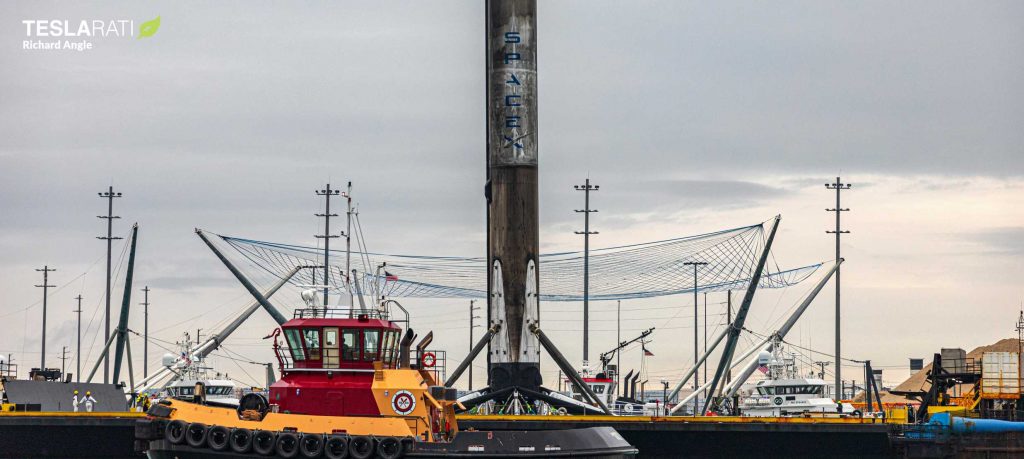
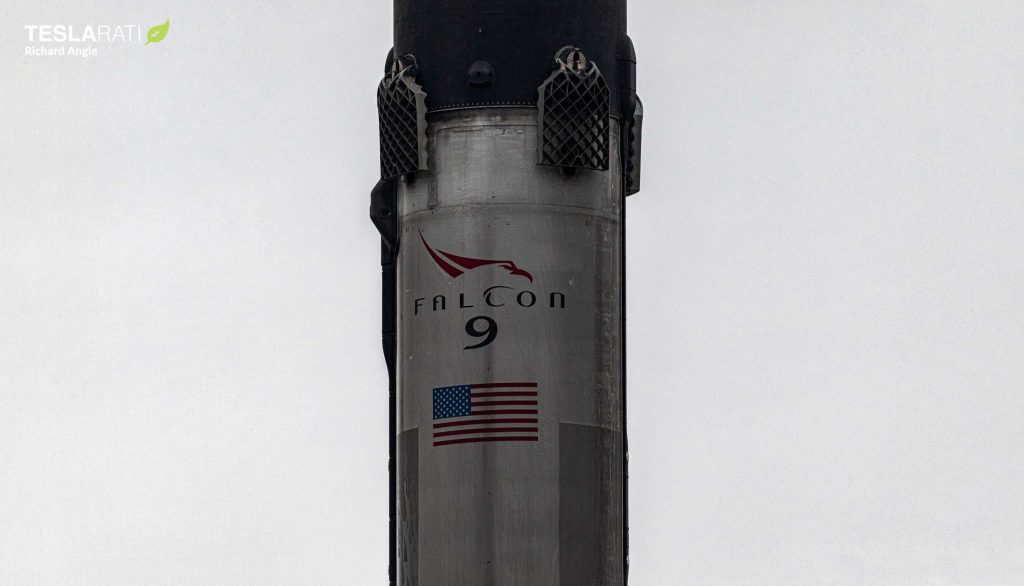
The results of that unintentionally hard landing are extremely apparent in photos taken of the same booster after its first (March 2019) and third (Jan 2020) landings on drone ship OCISLY, compared above. Taken from almost identical perspectives as the drone ship passed through the mouth of Port Canaveral, the difference in the booster’s height and stance are hard to miss, with B1051’s engine bells and the black ‘belt’ of its heat-shielded engine section clearly sitting several feet lower after Starlink V1 L3.
While subtle, the most important difference is near the tips of each visible landing leg’s telescoping boom, visible in the form of a final, smaller cylinder on the left (earlier) image. On the right, that cylinder has effectively disappeared. This is actually an intentional feature of Falcon 9’s landing leg design: known as a ‘crush core’, the tip of each leg boom holds a roughly 1m (3ft) long cylinder of aluminum honeycomb, optimized to lose structural integrity (crush) only after a specific amount of force is applied. In essence, those crush cores serve as dead-simple, single-use shock absorbers that can be reused as long as a given booster’s landing is gentle enough.
B1051’s third landing was definitely not gentle enough, but it appears that the booster’s rough fall onto the drone ship’s deck was just within the safety margins those crush cores provide. Why B1051 fell onto the deck is unclear, potentially caused by the drone being at the bottom of a swell or a last-second anomaly with the booster’s landing engine. Thankfully, regardless of the cause of the anomaly, B1051’s crush cores can be quite easily replaced, meaning that the booster can remain operational as long as its hard landing didn’t cause any less-visible damage or stress elsewhere on the rocket.
In short, SpaceX smart design decisions very likely allowed a part worth just a few thousand dollars to save a Falcon 9 booster worth tens of millions of dollars from the scrap heap. With a little luck, B1051 should have at least several more launches in its future before entering retirement.
Check out Teslarati’s Marketplace! We offer Tesla accessories, including for the Tesla Cybertruck and Tesla Model 3.

News
Tesla China delivery centers look packed as 2025 comes to a close
Needless to say, it appears that Tesla China seems intent on ending 2025 on a strong note.

Tesla’s delivery centers in China seem to be absolutely packed as the final days of 2025 wind down, with photos on social media showing delivery locations being filled wall-to-wall with vehicles waiting for their new owners.
Needless to say, it appears that Tesla China seems intent on ending 2025 on a strong note.
Full delivery center hints at year-end demand surge
A recent image from a Chinese delivery center posted by industry watcher @Tslachan on X revealed rows upon rows of freshly prepared Model Y and Model 3 units, some of which were adorned with red bows and teddy bears. Some customers also seem to be looking over their vehicles with Tesla delivery staff.
The images hint at a strong year-end push to clear inventory and deliver as many vehicles as possible. Interestingly enough, several Model Y L vehicles could be seen in the photos, hinting at the demand for the extended wheelbase-six seat variant of the best-selling all-electric crossover.
Strong demand in China
Consumer demand for the Model Y and Model 3 in China seems to be quite notable. This could be inferred from the estimated delivery dates for the Model 3 and Model Y, which have been extended to February 2026 for several variants. Apart from this, the Model Y and Model 3 also continue to rank well in China’s premium EV segment.
From January to November alone, the Model Y took China’s number one spot in the RMB 200,000-RMB 300,000 segment for electric vehicles, selling 359,463 units. The Model 3 sedan took third place, selling 172,392. This is quite impressive considering that both the Model Y and Model 3 are still priced at a premium compared to some of their rivals, such as the Xiaomi SU7 and YU7.
With delivery centers in December being quite busy, it does seem like Tesla China will end the year on a strong note once more.
News
Tesla Giga Berlin draws “red line” over IG Metall union’s 35-hour week demands
Factory manager André Thierig has drawn a “red line” against reducing Giga Berlin’s workweek to 35 hours, while highlighting that Tesla has actually increased its workers’ salaries more substantially than other carmakers in the country.

Tesla Giga Berlin has found itself in a new labor dispute in Germany, where union IG Metall is pushing for adoption of a collective agreement to boost wages and implement changes, such as a 35-hour workweek.
In a comment, Giga Berlin manager André Thierig drew a “red line” against reducing Giga Berlin’s workweek to 35 hours, while highlighting that Tesla has actually increased its workers’ salaries more substantially than other carmakers in the country.
Tesla factory manager’s “red line”
Tesla Germany is expected to hold a works council election in 2026, which André Thierig considers very important. As per the Giga Berlin plant manager, Giga Berlin’s plant expansion plans might be put on hold if the election favors the union. He also spoke against some of the changes that IG Metall is seeking to implement in the factory, like a 35-hour week, as noted in an rbb24 report.
“The discussion about a 35-hour week is a red line for me. We will not cross it,” Theirig said.
“(The election) will determine whether we can continue our successful path in the future in an independent, flexible, and unbureaucratic manner. Personally, I cannot imagine that the decision-makers in the USA will continue to push ahead with the factory expansion if the election results favor IG Metall.”
Giga Berlin’s wage increase
IG Metall district manager Jan Otto told the German news agency DPA that without a collective agreement, Tesla’s wages remain significantly below levels at other German car factories. He noted the company excuses this by referencing its lowest pay grade, but added: “The two lowest pay grades are not even used in car factories.”
In response, Tesla noted that it has raised the wages of Gigafactory Berlin’s workers more than their German competitors. Thierig noted that with a collective agreement, Giga Berlin’s workers would have seen a 2% wage increase this year. But thanks to Tesla not being unionized, Gigafactory Berlin workers were able to receive a 4% increase, as noted in a CarUp report.
“There was a wage increase of 2% this year in the current collective agreement. Because we are in a different economic situation than the industry as a whole, we were able to double the wages – by 4%. Since production started, this corresponds to a wage increase of more than 25% in less than four years,” Thierig stated.
News
Tesla is seeing a lot of momentum from young Koreans in their 20s-30s: report
From January to November, young buyers purchased over 21,000 Teslas, putting it far ahead of fellow imported rivals like BMW and Mercedes-Benz.

Tesla has captured the hearts of South Korea’s 20s-30s demographic, emerging as the group’s top-selling imported car brand in 2025. From January to November, young buyers purchased over 21,000 Teslas, putting it far ahead of fellow imported rivals like BMW and Mercedes-Benz.
Industry experts cited by The Economist attributed this “Tesla frenzy” to fandom culture, where buyers prioritize the brand over traditional car attributes, similar to snapping up the latest iPhone.
Model Y dominates among young buyers
Data from the Korea Imported Automobile Association showed that Tesla sold 21,757 vehicles to the 20s-30s demographic through November, compared to BMW’s 13,666 and Mercedes-Benz’s 6,983. The Model Y led the list overwhelmingly, with variants like the standard and Long Range models topping purchases for both young men and women.
Young men bought around 16,000 Teslas, mostly Model Y (over 15,000 units), followed by Model 3. Young women followed a similar pattern, favoring Model Y (3,888 units) and Model 3 (1,083 units). The Cybertruck saw minimal sales in this group.
The Model Y’s appeal lies in its family-friendly SUV design, 400-500 km range, quick acceleration, and spacious cargo, which is ideal for commuting and leisure. The Model 3, on the other hand, serves as an accessible entry point with lower pricing, which is valuable considering the country’s EV subsidies.
The Tesla boom
Experts described Tesla’s popularity as “fandom culture,” where young buyers embrace the brand despite criticisms from skeptics. Professor Lee Ho-geun called Tesla a “typical early adopter brand,” comparing purchases to iPhones.
Professor Kim Pil-soo noted that young people view Tesla more as a gadget than a car, and they are likely drawn by marketing, subsidies, and perceived value. They also tend to overlook news of numerous recalls, which are mostly over-the-air software updates, and controversies tied to the company.
Tesla’s position as Korea’s top import for 2025 seems secured. As noted by the publication, Tesla’s December sales figures have not been reported yet, but market analysts have suggested that Tesla has all but secured the top spot among the country’s imported cars this year.
